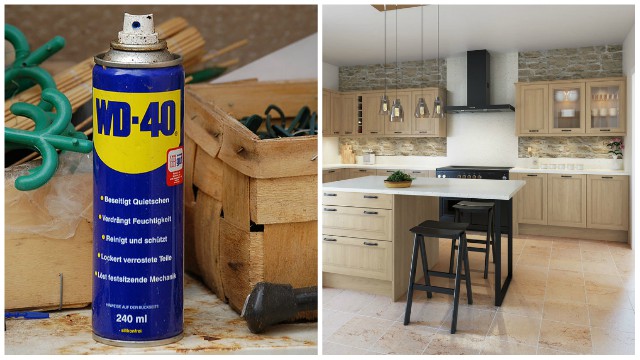WD-40 is a well-known and versatile product with a wide range of applications. This is the WD-40: A Kitchen How to Guide. Besides the normal uses, there are some uncommon and practical hacks for using WD-40 in your kitchen. Each hack is listed as a subtitle and organized in alphabetical order for easy reference. Remember to clean surfaces thoroughly after using WD-40 to ensure they are safe for food preparation.
Clean Grease and Grime in the Kitchen:
Spray WD-40 on a cloth or sponge and use it to clean grease and grime from kitchen surfaces, such as stovetops*, ovens, and exhaust fans. This can help you get rid of stubborn dirt and buildup without excessive scrubbing.
*It is not recommended for use on glass top stoves. The chemicals in WD-40 may damage the glass surface or leave a residue that could be difficult to remove. Instead, use a cleaner specifically designed for glass top stoves or a mixture of baking soda and water to clean the surface safely and effectively.
Clean Stainless-Steel Appliances:
Apply WD-40 to a soft cloth and gently rub the surface of your stainless-steel appliances to remove fingerprints and smudges, leaving a clean and shiny finish. This method is especially useful for maintaining the appearance of your refrigerator, dishwasher, or oven.
Free Stuck Measuring Cups or Spoons:
If measuring cups or spoons are nested and stuck together, spray WD-40 around the edges and gently separate them. This can save you time and frustration when trying to access the right measuring tool for your recipe.
Loosen Stuck Jar Lids:
If you have a jar lid that’s difficult to open, spray a small amount of WD-40 around the edge of the lid and let it sit for a few minutes. This should help loosen the lid and make it easier to open, allowing you to access the contents without straining your hands.
Remove Lime Deposits from Faucets:
Spray WD-40 onto a cloth and rub it over faucets or fixtures with lime deposits to help dissolve and remove the buildup. This can help restore the appearance and functionality of your kitchen sink and faucets.
Remove Sticky Residue:
If you have sticky residue on your kitchen countertops, appliances, or other surfaces, spray WD-40 onto a cloth and gently rub the area to remove the residue. This can be particularly helpful when trying to remove stubborn labels or adhesive from containers or jars.
These uncommon WD-40 hacks can help make your time in the kitchen more efficient and enjoyable. Remember to always clean surfaces thoroughly with warm, soapy water after using WD-40 to ensure they are safe for food preparation. By incorporating these tips into your routine, you can get the most out of this versatile product in your kitchen.

